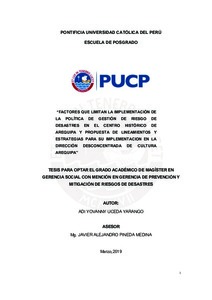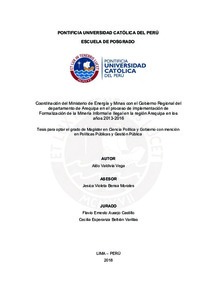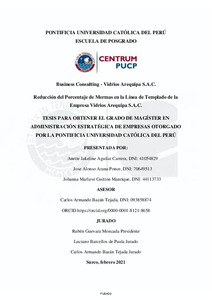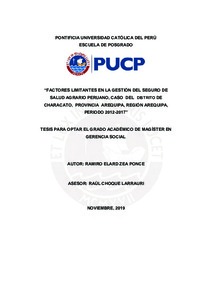| dc.contributor.advisor | Pineda Medina, Javier Alejandro | |
| dc.contributor.author | Uceda Yarango, Adi Yovanny | es_ES |
| dc.date.accessioned | 2019-05-02T20:15:08Z | es_ES |
| dc.date.available | 2019-05-02T20:15:08Z | |
| dc.date.available | 2019-05-02T20:15:08Z | es_ES |
| dc.date.created | 2019 | es_ES |
| dc.date.issued | 2019-05-02 | es_ES |
| dc.identifier.uri | http://hdl.handle.net/20.500.12404/14093 | |
| dc.description.abstract | PERU; país extraordinario por el patrimonio cultural con el que cuenta; poseedor de una de las siete maravillas del mundo moderno “Machu Picchu”; ciudadela que congregan turistas de diversas nacionalidades por su belleza; pero no solo tenemos esa riqueza patrimonial sino también contamos con una variedad de áreas urbanas consideradas patrimonio de la humanidad, entre estas el Centro Histórico de Arequipa; más conocida como: “La Noble, La Ciudad de los Libres, La Ciudad del Sillar, La Ciudad Blanca, La Blanca Ciudad, la Ciudad Sísmica” entre otras denominaciones que nacen desde la colonia; ciudad que cuenta con el majestuoso pero temerario Misti; rica en gastronomía y patrimonio vivo; estas últimas razones esenciales para el desarrollo de la presente investigación.
De la misma forma que Arequipa cuenta con un valioso patrimonio cultural; debemos resaltar que esta ciudad está ubicada geográficamente en el cinturón de fuego del pacifico, generándose vulnerabilidades ante los desastres naturales; razones más que suficientes para estar en la obligación de accionar todos los medios técnicos y económicos a fin de mitigar los efectos de los desastres naturales que puedan ocasionarse en nuestro territorio y que a la vez pueden producir pérdidas humanas y perdida de nuestro patrimonio cultural; esta última irrecuperable por ser un recurso no renovable.
Se desea contribuir a la protección del patrimonio inmueble mediante el análisis de los factores que limitan la implementación de la Ley N° 29664 del Sistema Nacional de Gestión de Riesgo de Desastres SINAGERD; en el centro histórico de Arequipa y trabajar una propuesta: lineamientos y estrategias para la aplicación dicha política, principalmente en la Dirección Desconcentrada de Cultura de esta ciudad.
El tema está muy vinculado al tema de gestión social, a la visión del futuro, así como la planificación estratégica, puntos importantes de la Gerencia Social. Esta investigación quiere contribuir, a fortalecer un equipo humano intersectorial participativo y sinérgico (los principales actores sociales) donde se democraticen las decisiones, se recojan las experiencias y los aprendizajes para que tenga viabilidad la implementación de dicha política.
Acción que será posible a raíz que en correspondencia a esta problemática se han emitido acciones internacionales en salvaguarda de las áreas patrimoniales respecto al riesgo natural; no ajeno a ello en nuestro país se ha emitido la Ley N°29664. “Ley del Sistema Nacional de Gestión del Riesgo de Desastres (SINAGERD)”, que une esfuerzos del MEF, PCM y el Congreso, en materia de institucionalidad para prevención de desastres; orientando políticas, estrategias y acciones en todos los niveles de Gobierno y de la sociedad.
La preparación que ofrece la Maestría en Gerencia Social nos permite enfrentar los problemas mediante la aplicación de diversos instrumentos de gestión, durante la planificación de acciones, ejecución, y el monitoreo; conocimientos que unidos a los adquiridos en el desarrollo profesional más específico sobre urbanismo y arquitectura me dará mejores condiciones para aportar a una propuesta viable, contribuyendo así a la gestión de los gobiernos locales y regionales que tengan centros históricos, y también a los arquitectos que quieran especializarse en este tema.
Es primordial que cada espacio territorial con el que contamos esté protegido ante los desastres naturales; sin embargo en la presente después de haber realizado un análisis; se ha elegido el Centro Histórico de Arequipa para el desarrollo del estudio; por ser trascendental históricamente, ser patrimonio de la humanidad y contar con diversos factores naturales que convierten en vulnerable este espacio territorial al ser afectado por volcanes los cuales se encuentran activos; terremotos con mayor índice de incidencia y magnitud e inundaciones.
Es importante resaltar que la presente pretende ser un aporte para la toma de decisiones oportuna de entes técnicos; para evitar la pérdida de nuestra identidad nacional y mundial a causa de desastres naturales; teniendo la enmienda que un patrimonio cultural que se pierde, no puede ser recuperado, su pérdida es invalorable.
El diseño de la investigación es planteada y desarrollada en el tercer capítulo de la investigación; para el desarrollo de la presente se ha seleccionado el tipo de investigación diagnóstico y/o diagnostica; empleándose una metodología de investigación Mixta: Cualitativa-Cuantitativa, determinando posteriormente las unidades de Análisis de la Investigación; muestreo entre otros que se detallan en este capítulo.
Algunos de los resultados que se han obtenido en esta investigación nos demuestran que la mayoría de personal técnico no cuenta con un conocimiento básico sobre el tema, más aún, no cuentan con directivas e instrumentos normativos que les permitan la implementación de la política social.
El tema del desconocimiento de sus funciones de las autoridades del ente encargado de las acciones básicas que deben de cumplir; además del tema de los conflictos, y la voluntad política, son algunos de los factores limitantes en la implementación de la política sobre Riesgo de Desastres en el centro histórico de Arequipa
Por ultimo teniendo en consideración lo antes mencionado en la presente se proponen lineamientos y estrategias a aplicar en las instituciones involucradas principalmente en la Dirección Desconcentrada de Arequipa, al ser la encargada por ley de la protección de áreas patrimoniales en nuestro país.
El objetivo de la investigación es analizar los factores que influyen en la implementación de la política peruana de gestión de riesgos y desastres enmarcada en la Ley del Sistema Nacional de Gestión de Riesgos y Desastres SINAGERD; con el objeto de encontrar limitantes que están dificultando su implementación en el Centro Histórico de Arequipa, y proponer lineamientos y estrategias para la implementación de la política en la Dirección Desconcentrada de Cultura. | es_ES |
| dc.description.abstract | PERU; An extraordinary country for the cultural heritage with which it counts; Possessor of one of the seven wonders of the modern world "Machu Picchu"; Citadel that congregate tourists of diverse nationalities by its beauty; But not only do we have that rich heritage but we also have a variety of urban areas considered world heritage, among them the Historical Center of Arequipa; Known as "The Noble, The City of Free, The City of Sillar, The White City, The White City, The Seismic City" among other denominations that are born from the colony; City that counts on the majestic but reckless Misti; Rich in gastronomy and living heritage; These latter reasons essential for the development of the present investigation.
The why?; Because just as we have a valuable cultural heritage; This city is located geographically in the belt of fire of the pacific, generating vulnerabilities before the natural disasters; Reasons more than sufficient to be in the obligation to use all the technical and economic means to mitigate the effects of the natural disasters that may be caused in our territory and that at the same time can produce human losses and loss of our cultural heritage; The latter irrecoverable because it is a non-renewable resource.
The present one wishes to contribute to the protection of the real estate property through the analysis of the factors that limit the implementation of Law No. 29664 of the National System of Management of Risk of Disasters SINAGERD; In the historical center of Arequipa and work on a proposal: guidelines and strategies for the implementation of said policy, mainly in the Decentralized Directorate of Culture of this city.
The theme is closely linked to the theme of social management, to the vision of the future, as well as strategic planning, important points of Social Management. This research wants to contribute, to strengthen a participatory and synergic intersectorial human team (the main social actors) where the decisions are democratized, to collect the experiences and the learning so that the implementation of this policy is feasible.
Action that will be possible because in correspondence to this problem have been issued international actions to safeguard the patrimonial areas with respect to natural risk; Not foreign to this in our country has issued LAW No. 29664. "Law of the National Disaster Risk Management System (SINAGERD)," which links efforts of MEF, PCM and Congress, in terms of institutions for disaster prevention; Guiding policies, strategies and actions at all levels of government and society.
The preparation offered by the Master in Social Management allows us to face the problems by applying different management tools, during the planning of actions, execution, and monitoring; Knowledge that together with those acquired in the more specific professional development on urbanism and architecture will give me better conditions to contribute to a viable proposal, thus contributing to the management of local and regional governments that have historic centers, as well as the architects they want Specialize in this topic.
It is essential that each territorial space we have is protected from natural disasters; However in the present after having made an analysis; The Historical Center of Arequipa has been chosen for the development of the study; For being historically transcendental, to be a patrimony of humanity and to count on diverse natural factors that make this territorial space vulnerable to being affected by volcanoes which are active; Earthquakes with higher incidence and magnitude and flood.
The objective of this paper is to analyze the factors that limit the implementation of the Peruvian policy of risk and disaster management, as set out in the SINAGERD National Risk and Disaster Management System Law; In order to find constraints that are hindering its implementation in the Historic Center of Arequipa, and to propose guidelines and strategies for the implementation of the policy in the Decentralized Culture Directorate.
It is important to emphasize that the present one pretends to be a contribution for the timely decision of technical entities; To prevent the loss of our national and global identity due to natural disasters; Having the amendment that a cultural heritage that is lost, can not be recovered, its loss is invaluable.
The design of the research is raised and developed in the third chapter of the research; For the development of the present the type of diagnostic and / or diagnostic research has been selected; Using a methodology of mixed research: Qualitative-Quantitative, determining later the units of Analysis of the Investigation; Among others that are detailed in this chapter.
Some of the results obtained in this research show that most technical personnel do not have basic knowledge on the subject, nor do they have normative directives and instruments that allow them to implement social policy.
The subject of ignorance of their functions of the authorities of the entity in charge of the basic actions that must comply; In addition to the issue of conflicts, and political will, are some of the limiting factors in the implementation of the Disaster Risk Policy in the historic center of Arequipa.
Lastly, taking into account the foregoing, we propose guidelines and strategies to be applied in the institutions involved mainly in the Arequipa Decentralized Management, as it is the one charged by law for the protection of patrimonial areas in our country. | es_ES |
| dc.description.uri | Tesis | es_ES |
| dc.language.iso | spa | es_ES |
| dc.publisher | Pontificia Universidad Católica del Perú | es_ES |
| dc.rights | Atribución-NoComercial-SinDerivadas 2.5 Perú | * |
| dc.rights | info:eu-repo/semantics/openAccess | es_ES |
| dc.rights.uri | http://creativecommons.org/licenses/by-nc-nd/2.5/pe/ | * |
| dc.subject | Administración de riesgos--Perú--Arequipa | es_ES |
| dc.subject | Administración pública--Perú--Arequipa | es_ES |
| dc.subject | Monumentos históricos--Conservación y restauración | es_ES |
| dc.subject | Monumentos históricos--Perú--Arequipa | es_ES |
| dc.subject | Espacio público--Conservación y restauración | es_ES |
| dc.subject | Desastres--Legislación | es_ES |
| dc.subject | Desastres--Prevención | es_ES |
| dc.subject | Planificación urbana--Perú--Arequipa | es_ES |
| dc.title | Factores que limitan la implementación de la política de gestión de riesgo de desastres en el centro histórico de Arequipa y propuesta de lineamientos y estrategias para su implementación en la Dirección Desconcentrada de Cultura Arequipa | es_ES |
| dc.type | info:eu-repo/semantics/masterThesis | es_ES |
| thesis.degree.name | Maestro en Gerencia Social con mención en Gerencia de Prevención y Mitigación de Riesgos de Desastres | es_ES |
| thesis.degree.level | Maestría | es_ES |
| thesis.degree.grantor | Pontificia Universidad Católica del Perú. Escuela de Posgrado | es_ES |
| thesis.degree.discipline | Gerencia Social con mención en Gerencia de Prevención y Mitigación de Riesgos de Desastres | es_ES |
| renati.discipline | 314387 | es_ES |
| renati.level | https://purl.org/pe-repo/renati/level#maestro | es_ES |
| renati.type | http://purl.org/pe-repo/renati/type#tesis | es_ES |
| dc.publisher.country | PE | es_ES |
| dc.subject.ocde | https://purl.org/pe-repo/ocde/ford#5.02.04 | es_ES |









